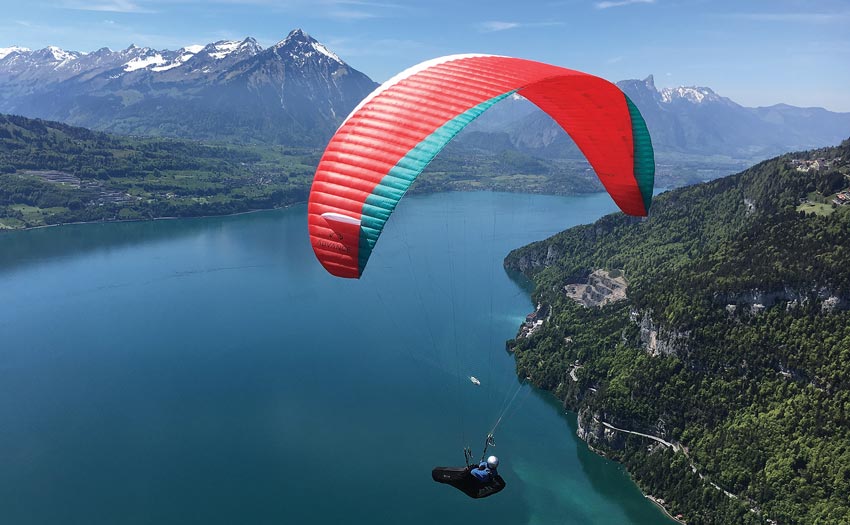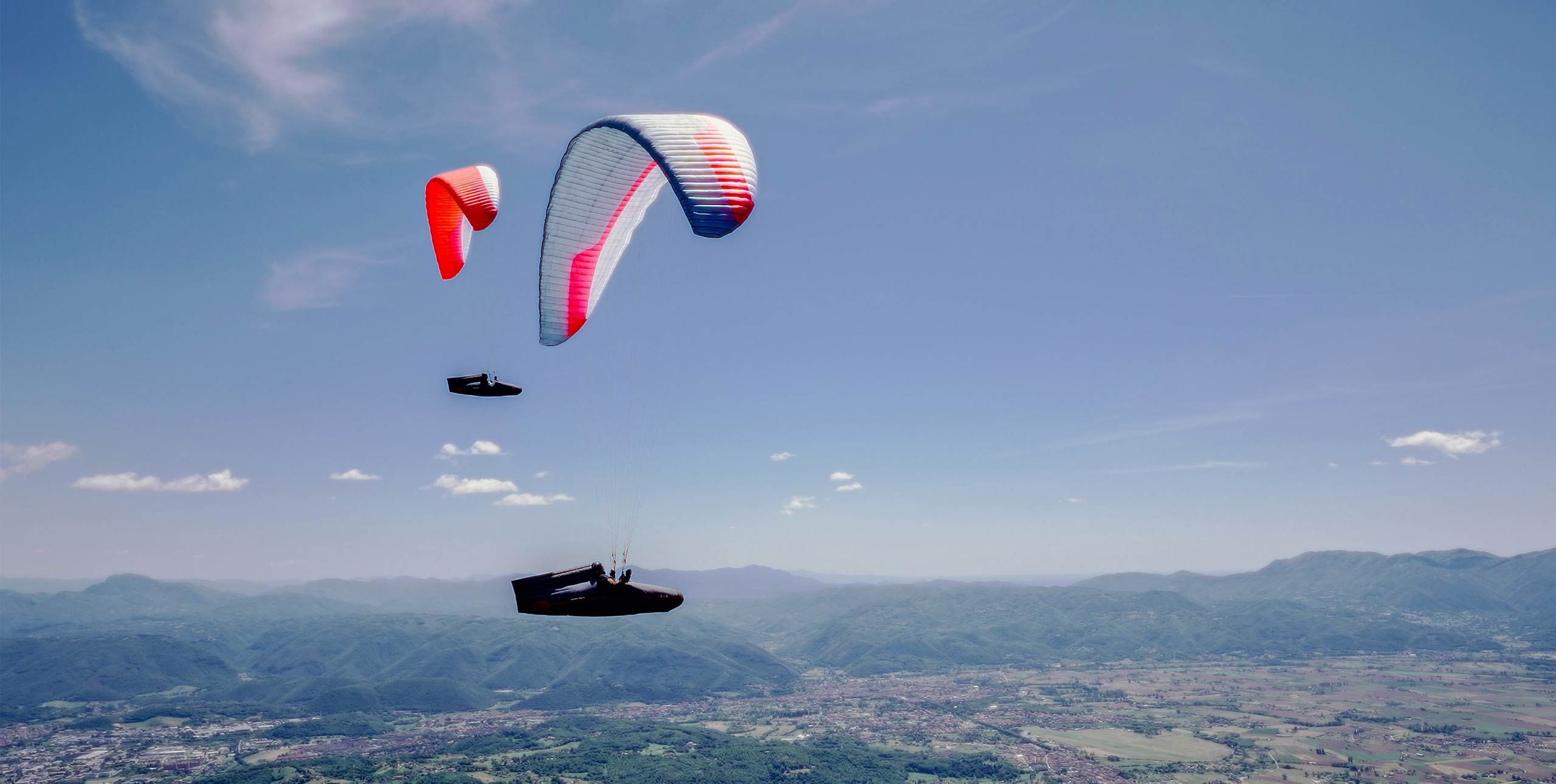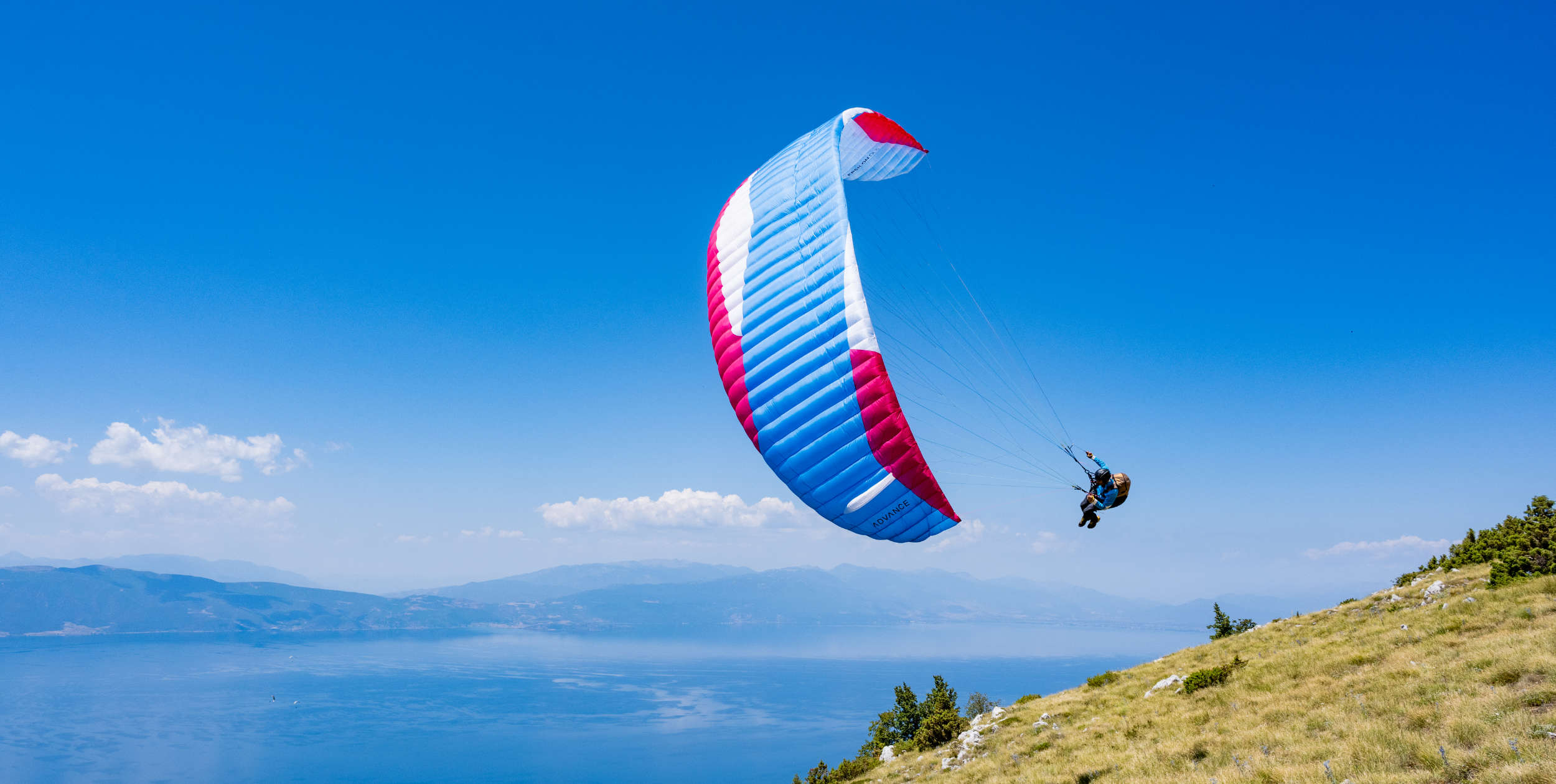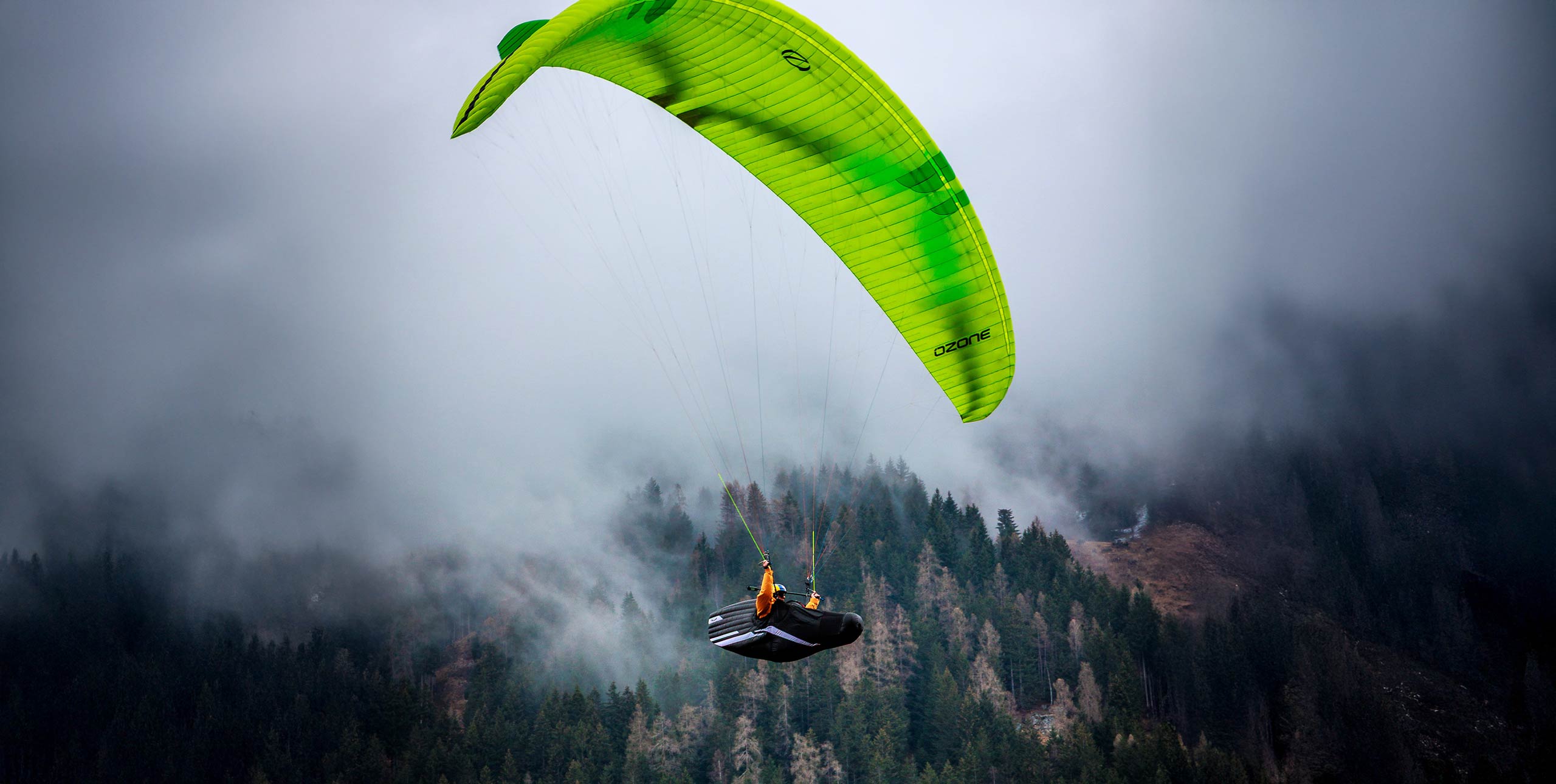
When Advance release a new wing there is always plenty of interest. Enter the Sigma 10. The strap line “Epic XC” makes it clear what the glider is intended for. Its predecessor, at the forgiving end of EN C, was a lovely glider though might have suffered from not having a sufficiently performance-orientated design in the competitive sports class market. The Sigma 10 resets the game. Whilst aiming firmly at the middle of the EN C class, the glider ups the sportiness and the performance in healthy doses.
The review flying consisted of three days of awesome flying in the Bernese Oberland of Switzerland at Amisbühl, Jungfraujoch and First above Grindelwald; some mixed UK flying; and a week guiding other pilots at the FlyFurther XC event based at Tolmin in Slovenia.

Photo: Andy Busslinger
First impression
There are now five sizes as opposed to four covering roughly the same range of weights. Each glider has a certified weight range and within it sits an “ideal weight range”. The certified weight ranges overlap between 7kg and 11kg, however the ideal weight ranges butt up against each other. The 25 size that I ended up flying has an ideal range of 85-97kg. I have to admit that I was cynical about how a glider can be “ideal” over such a wide range. I was able to fly at a variety of weights from 86-95kg.
My introduction was a gentle late afternoon flight from the Amisbühl launch above Interlaken. I flew at 86kg and had a ridiculously good climb rate. All the other gliders struggled to get up to me and when something just slightly better came through I just climbed away and could survey everyone form nearly 500m higher.
What was a really pleasant surprise was the precise and dynamic handling. As soon you take the slack out of a brake line you feel completely in touch with the trailing edge. I had easy agility, instant response to small amounts of brake and precision in the turn. The brakes are more linear than the Sigma 9, which needed a longer pull when thermalling. I found the shorter travel on the Sigma 10 reduced the effort and I never felt my arms tiring. Nothing shouted at me “you are too light for this size.”

Photo: Valéry Chapuis
The high mountains
I am sure that Advance’s head of marketing Valéry Chapuis was not trying to unsettle me, but after the previous day’s flight, I now found myself on a convex launch pad in deep snow at nearly 3,500m on the Jungfraujoch. A group of Japanese tourists, stripped to their boxer shorts, larked around in the snow whooping with delight.
I was more concerned about the light fickle breeze swapping from one side of the launch to the other. I definitely didn’t want a tailwind for this! I committed, laid the glider out in normal forward launch position and went for it. It was total non-event.
On active thermic launches the glider was similarly reassuring provided I gave it a really good run to power the glider through uncertain air. On several light-wind thermic launches the Sigma 10 swooped into the air where other gliders fluffed. In strong wind I used my now favourite Cobra method and the glider was a total pussycat. Other methods worked just as well.
Gliding away from the Jungfraujoch, my breathing slowed and I could take in the simply awesome mountain landscapes. Back on-task, I aimed at the ridge-line above Kleine Scheidegg. Somehow I had picked a terrible line and compared to another Sigma 10 a couple of hundred metres to my right, I seemed to be falling from the sky.
Of course, a N-S orientated ridge line was never going to perfect for catching the midday sun and I had to fight for scraps at Tschuggen before reaching the better climbs at Männlichen. A stable layer meant that even here it was a bit of fight to climb.
Sebastian Ospina came to join to me. He had borrowed a Sigma 10 for the day and was at the top of the ideal weight range whist I was still low in the range. Would the extra precision and agility of Seb’s heavily loaded Sigma 10 score over my floatiness? Seb is a world-class pilot and way better than me, but even so I seemed to have the edge. I think the key to this is the way the Sigma 10 keeps its taut and precise piloting throughout the weight range.
We made the 10km crossing over Interlaken to top-land above Beatenberg to compare notes. Re-launching, we played in the afternoon thermals, Seb pointing his camera and me just having fun. Seb shouted across “turn again!” and I was straight on a wing-tip to come back into Seb’s view finder. The Sigma 10 has strong playful side to add to its main raison d’être as an XC machine.
Hugh Miller likened the Advance Omega X-Alps to going for a ride on your Swiss Uncle’s luxury yacht. The Sigma 10 is more like going for a mountain bike ride with a cheeky teenager. You get carried along with the flow and end up doing things you wouldn’t normally do. The fun-factor wouldn’t quite match the UP Trango XC3, for example, but the UP is a more demanding glider requiring quite a bit more attention in active air.

Photo: Andy Busslinger
Hat-trick
To complete the hat-trick of beautiful flights before heading back to the UK we went to the First launch above Grindelwald. The day looked good, and in fact it was pumping! All the stability from the previous day was gone and we had fantastic conditions for an XC to the west.
This time I flew at 94kg. The handling was fractionally more precise. I was really surprised how little difference the additional weight made. It’s quite a contrast to lots of other gliders. The only real difference was the lower feedback through the risers. When lightly loaded I definitely had a bit more roll movement pulling on the carabiners. It is certainly not a problem; rather it is just something to be aware of and to get used to. I see no reason to argue with Advance’s claim that the glider flies really well throughout the “ideal weight range.”
The feedback from the glider stood out on this flight with a balance of clear information coming through the brakes and the risers. The pull towards lift was very clear and varied between gentle and strong, depending on how strong the lift was.
Alive in the air
From the first glide I had the feeling that the Sigma 10 goes very well. In XC conditions it is alive to the air and helped me to find good lines (most of the time). There is a nice taught feel to the glider, especially on bar. In active air there is more of a tendency for the glider to pull forwards than be knocked back.
There seems to be a big step forward in the glide through moving air and Advance say this is something they say they have worked very hard to achieve. The speed bar is a lovely smooth two-stage affair with their handy SPI (Speed Performance Indicator)
In lively conditions I found the C handles rather reassuring. I still believe that finessing the speed bar is always better on a three-liner, provided you can do it. However, I bet many pilots will use the rear riser option. I am sure that the best approach to using them is to give the merest hint of pressure, trying not to slow the glider at all, but just to feel its movements and then give bigger inputs of a few cm to stop sudden pitches. Pushing hard through turbulence at speed I was interested to see how much the glider would take. I had no collapses on any glides although there was a hint of lines unloading for the blink of an eye, but a collapse never came. Impressive!
FlyFurther in Slovenia
My week in Slovenia, served to reinforce my views. It is testament to the glider that I didn’t pay it much attention whist I was looking after other pilots; it just got on with the job. One 30% tip collapse on the edge of a thermal which opened instantly was the sum total of the drama. Big ears worked OK although the glider did rock back and forth a little both with and without speed bar.

Photo: Pat Dower
Design
The Sigma 10 brings Advance’s main XC glider fully up to date. An aspect ratio at 6.16 and cell count of 66 are both up from the Sigma 9. Kari Eisenhut, who heads up the development team, and Silas Bosco, designer, explained their approach. Prototypes with and without mini-ribs showed that, unlike with the Sigma 9, there is benefit in performance.
They refined the line arrangement so, despite the higher aspect, there are fewer attachment points and an 11% drop in line consumption. It is nearly a pure three-liner except for four short D lines on each side.
Another new addition is the C-wires, which, in combination with the D lines, improve collapse behaviour, particularly for certification. Advance explained, “If there are no D-lines, the Cs act as a pivot during a front collapse. With the short D-lines the rear of the chord of the glider is held more as a block, making the collapse less violent and the recovery more predictable.” Silas added that this also helps maintain the shape of the glider in turbulence.
Silas also emphasised the amount of effort that has gone into getting the best from the materials on the glider. The positioning and orientation of the cloth weave creates “sliced diagonals” inside the glider, and new 3D panel shaping on the leading edge aims to reduce wrinkles. Judging by the number of comments from other pilots, it seems to have worked.
Other details catch the eye. The low-friction rings for the brake lines have been ditched in favour of small pulleys due to inconsistent quality of the rings from the manufacturer. When ordering, the pilot can choose any size of Comfortpack or Lightpack. No concertina bag is supplied, but I definitely would use one. The only special technique is to fold the sausage at the end of the reinforcements so they are not folded at all. It is easy to do and you end up with a nice short pack.
In conclusion
So how fulfilling is the Sigma 10? Some past Advance gliders have had a reserved character, but the Sigma 10, whilst not completely kicking this trait into touch, definitely has more fun factor. There is certainly no return to the slight sluggishness of the Sigma 7 and 8. It does this without sacrificing the attributes you expect from an XC glider. It all adds up to a fun, rewarding high performance glider.
Advance don’t have a habit of producing duff gliders so where does the Sigma 10 sit? I find myself leaning towards a bold statement: Advance may well have produced their best glider of all time!
****
Speed and glide
In gently moving air I managed a 2km glide in a light crosswind with a Sigma 9 and the Sigma 10 opened soon up a height advantage. In smooth air I had a four-minute trimspeed glide against a similarly loaded Skywalk Spice (S: 90-105kg) and we were evenly matched on speed and glide. The Spice is the light version of the Cayenne 5, regarded by many as the reference glider for the C class, so this is a strong showing for the Sigma 10.
I finally managed to hunt down a Cayenne 5 on an into-wind leg of an XC. He was flying at a bit over half-bar so I accelerated to match his speed. At first he gained altitude slightly in relation to me in the moving air but then I clawed it back and moved above. We swapped places a few times more, so I have to call it a score-draw.
It’s worth noting that the Sigma’s level of demand is mid-EN C/Sports category compared to the Cayenne 5, which is nearer to the top end of the C category. It just emphasises yet again how small the performance differences often are and how they should be well down the list when it comes to buying criteria.
Hugh did the speed testing using the Flymaster Probe: “At 98kg, the Sigma 10 has a trim speed of 38km/h which is quite fast – 2km/h faster than most C’s in fact, which we generally find have a trim of around 36km/h. This explains its nice amount of playful energy in the top of the brake range.
“Top speed is 50km/h, which again, is fast for a C and only 1-2km/h slower than the M6 and GTO2. So, some of the new generation of C’s have closed the gap on the D’s of 2014-2015 in terms of speed.”
My GPS measurements indicated an increase in speed of 14km/h at most when accelerated.
****
Five-minutes with Advance
What are you most proud of with the Sigma 10?
Silas Bosco: I think the big improvement in glide in moving air is a big achievement. Together with the great pitch and directional stability of the wing, it is a real pleasure to fly fast and far.
Where did the new ideas come from to make the improvement?
SB: The Sigma 10 has ideas from Hannes, Christian and me inside, it is a true teamwork achievement. The breakthrough was when Christian Proschek came up with new aerodynamic ideas which worked perfectly with the basic concept.
Why fit C-handles even though the glider is a three-liner?
Valéry Chapuis: Our research told us that the market demands the handles on this level of glider. Our design team are split 50:50. Kari and some of the others say it is better to work with the speedbar, the others – mostly the competition pilots with lots of experience with two-liners – like to control the glider also with the C-handles. The Sigma 10 reacts perfect on the C-handles, almost like a two-liner.
What else are you working on at the moment?
SB: We are finishing the X–Alps 2 in the bigger sizes. The research we did in developing the glide in thermic air on the Sigma 10 has fed directly into the X Alps 2. The Iota 2 is well underway and we are working on the Lightness 3.
Are there plans to make a standard weight EN D glider to sit alongside the X Alps 2?
Valéry Chapuis: A standard weight glider is a different concept to the light weight X-Alps 2 and would incorporate a lot off additional technology rather than just having full weight cloth. We are always working on ideas but have no immediate plans. We would only release something if it was a significant improvement.
****
To stay up to date and read our reviews first, subscribe to Cross Country











